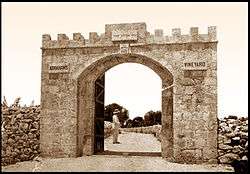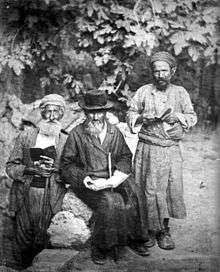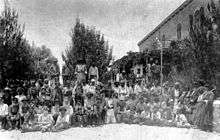Kerem Avraham

| Old Yishuv |
|---|
 |
| Key events |
| Key figures |
|
| Economy |
| Philanthropy |
| Communities |
| Synagogues |
| Related articles |
Kerem Avraham (lit. Avraham's Vineyard) is a neighbourhood near Geula in central Jerusalem, Israel, founded in 1855.[1] It is bounded by Malkhei Yisrael Street, Yechezkel Street, Tzefanya Street, and the Schneller Compound.
The mission house was one of the first structures to be built outside the Old City of Jerusalem; the others are the Schneller Orphanage, the Bishop Gobat school, Mishkenot Sha’ananim and the Russian Compound.[2]
History

Kerem Avraham was established by James Finn, British Consul in Ottoman Jerusalem, and his wife Elizabeth Anne Finn. Finn was a devout Christian, who belonged to the London Society for Promoting Christianity Amongst the Jews, but who did not engage in missionary work during his years in Jerusalem.
In 1853, Finn purchased Karm al-Khalil ("Abraham's Vineyard"), a 10-acre plot of barren land outside the walls of the Old City. There he established "The Industrial Plantation for Employment of Jews in Jerusalem" to train Jews in agriculture and other trades so they could become self-supporting, rather than relying on the halukka welfare distribution.[3][4] The manager was a Christian named Dunn who believed he was a descendant of the tribe of Dan.[5] Finn employed Jewish laborers to build the first house there in 1855 and cisterns for water storage were built.
After Finn's death, a soap-making factory was established by his widow and high quality kosher soap was produced which was sold locally and exported abroad. The soap was made from olive oil fat mixed with alkali, sourced from the ashes of the kali plant which grew in the Jordan valley. The soap production became the most widely known industry which took place at the compound.[6]
Israeli novelist Amos Oz grew up in Kerem Avraham in the 1940s. Most of the residents of Kerem Avraham today are Orthodox.[4]
References
| Wikimedia Commons has media related to Kerem Avraham. |
- ↑ History of Kerem Avraham
- ↑ Kark, Ruth; Oren-Nordheim, Michal (2001). Jerusalem and Its Environs: Quarters, Neighborhoods, Villages, 1800-1948. Wayne State University Press. pp. 74, table on p.82–86. ISBN 0-8143-2909-8.
The beginning of construction outside the Jerusalem Old City in the mid-19th century was linked to the changing relations between the Ottoman government and the European powers. After the Crimean War, various rights and privileges were extended to non-Muslims who now enjoyed greater tolerance and more security of life and property. All of this directly influenced the expansion of Jerusalem beyond the city walls. From the mid-1850s to the early 1860s, several new buildings rose outside the walls, among them the mission house of the English consul, James Finn, in what came to be known as Abraham’s Vineyard (Kerem Avraham), the Protestant school built by Bishop Samuel Gobat on Mount Zion; the Russian Compound; the Mishkenot Sha’ananim houses: and the Schneller Orphanage complex. These complexes were all built by foreigners, with funds from abroad, as semi-autonomous compounds encompassed by walls and with gates that were closed at night. Their appearance was European, and they stood out against the Middle-Eastern-style buildings of Palestine.
- ↑ "Jerusalem Architecture - Periods and Styles, European Christian Buildings Outside the Old City Walls, 1855-1918," David Kroyanker, Keter, 1987 (Hebrew) pp.419-21.
- 1 2 JUF News : Men in black
- ↑ History of Kerem Avraham
- ↑ Palestine: The Rebirth of an Ancient People, 1917, - Page 73.
Coordinates: 31°47′24.06″N 35°13′2.04″E / 31.7900167°N 35.2172333°E
